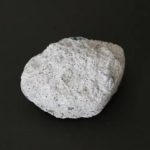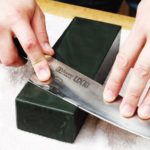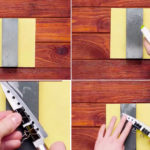During usage, we cannot avoid the deterioration of knives. This not only causes inconvenience but also reduces the service life of the object. Periodic sharpening of the knives does not help in cutting and slicing food faster. Moreover, a sharp knife blade saves time and makes the dish look more pleasing to the eye. In addition, sharp knives and scissors will last longer, helping the owner save money in the long run.
Therefore, understanding how to sharpen a knife properly is essential knowledge for every chef, from professionals to home cooks.
1. Use a whetstone
– Oilstone: Apply a little oil to the surface of the whetstone. Hold the knife at an angle of about 20 degrees to the surface of the stone and sharpen in an arc from the part near the handle to the tip of the blade. Repeat several times until the knife feels sharp.
– Waterstone: Soak the stone in water until there are no more air bubbles. Sharpen the knife on the wet stone, similar to the oilstone. The waterstone needs to be stored carefully to avoid excessive wear.
2. Use newspaper
Roll the newspaper into a cylinder shape and secure it with tape. Wet the paper roll with water.
Rub the blade of the knife on the newspaper at a certain angle, making sure to rub both sides of the blade. This action helps to straighten the blade and creates temporary sharpness.
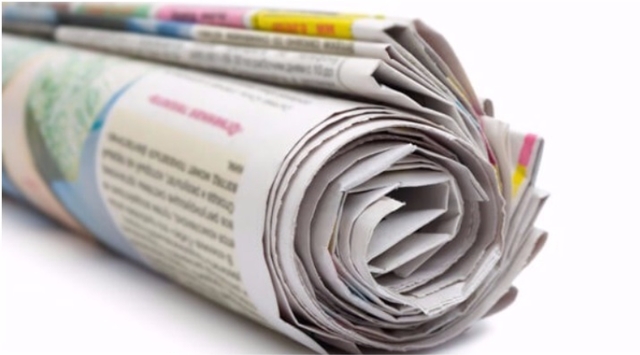
3. Sharpen the knife with a ceramic plate
Turn the plate upside down to expose the rough bottom.
Hold the knife at an angle of about 20 degrees and sharpen the knife on the rough part of the bottom of the plate. The sharpening motion should be firm and steady.
4. Use sandpaper
Place the sandpaper on a flat, hard surface such as a wooden cutting board.
Hold the knife at an angle and rub the blade of the knife over the sandpaper, moving the knife in an arc from the handle to the tip of the knife. Continue until the desired sharpness is achieved.
5. Use another knife
Hold the knife that needs to be sharpened and use the back of another knife (the non-sharp part) to sharpen.
Hold the two knives parallel and rub the blade of the knife to be sharpened on the back of the other knife, making sure to sharpen the entire blade.
6. Use a knife sharpener
A knife sharpener is a powerful aid. Currently, knife sharpeners are also equipped with many other convenient functions such as sharpening serrated blades, straight blades, sharpening scissors, sharpening screwdrivers, etc.
Depending on your usage needs, you can research and choose the types of knife sharpeners with suitable functions, meeting the usage needs of your family.
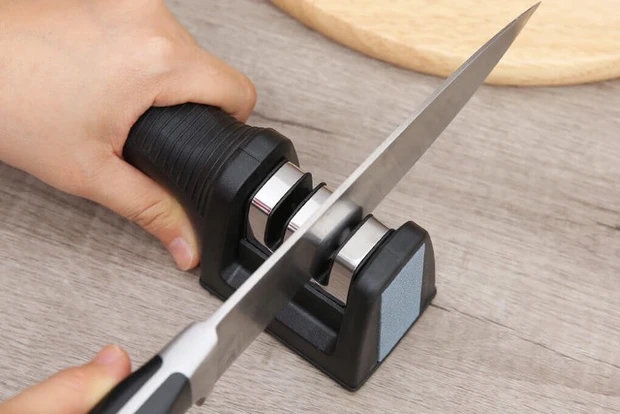
Safety note when sharpening knives: Wear protective gloves and sharpen knives carefully to avoid accidents.
Tips to keep knives sharp and shiny:
– Sharpen the knife regularly: Sharpen the knife regularly every 1-2 months or when you feel the knife is not sharp enough.
– Choose the right sharpening tool: Use a quality whetstone, suitable for each type of knife and the dullness of the blade. Oilstones are suitable for European knives, while waterstones are good for both Asian and European knives.
– Store knives properly: After use, wash the knife with warm water and dry it immediately. Avoiding moisture on the knife can corrode the blade.
– Use the knife for the right purpose: Do not use a slicing knife to chop bones or use a knife to open bottle caps. Each type of knife has its own purpose.
According to Life and Law
– Whetstone: You can use either an oilstone or a waterstone. For an oilstone, apply a small amount of oil to the surface and hold your knife at a 20-degree angle. Sharpen in an arc from the handle to the tip. With a waterstone, soak it in water first, then sharpen similarly.
– Newspaper: Roll a piece of newspaper into a cylinder, secure it with tape, and wet it. Rub the knife blade on the paper at an angle, ensuring you do both sides.
– Ceramic Plate: Expose the rough bottom of a ceramic plate. Hold your knife at a 20-degree angle and sharpen on the rough surface with a firm, steady motion.
– Sandpaper: Place sandpaper on a flat, hard surface. Hold your knife at an angle and rub the blade over the sandpaper in an arc until you achieve the desired sharpness.
– Another Knife: Use the back of one knife to sharpen another. Hold them parallel and rub the blade to be sharpened on the back of the other knife.
– Knife Sharpener: A dedicated knife sharpener is a powerful tool, often featuring multiple functions for different blade types.
“How to Sharpen a Knife in 3 Easy Steps Using Newspaper”
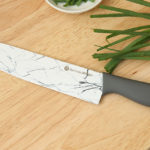 Newspaper”’>
Newspaper”’>Tired of having dull knives in your kitchen? Don’t worry – there’s a simple solution! In this article, we will demonstrate an easy way to sharpen your knives using nothing but common newspapers. Your knives will be as sharp as ever in no time!
Using a Sharpening Stone: Tips for Choosing and Sharpening Your Razor
Sharp knives can make a huge difference to your kitchen experience, so don’t forget to keep them sharpened! Electric Appliances XANH’s “Tips for the Kitchen” section provides detailed advice on how to choose the best knife sharpener stone to keep your tools in good condition. Read on to find out more!


























